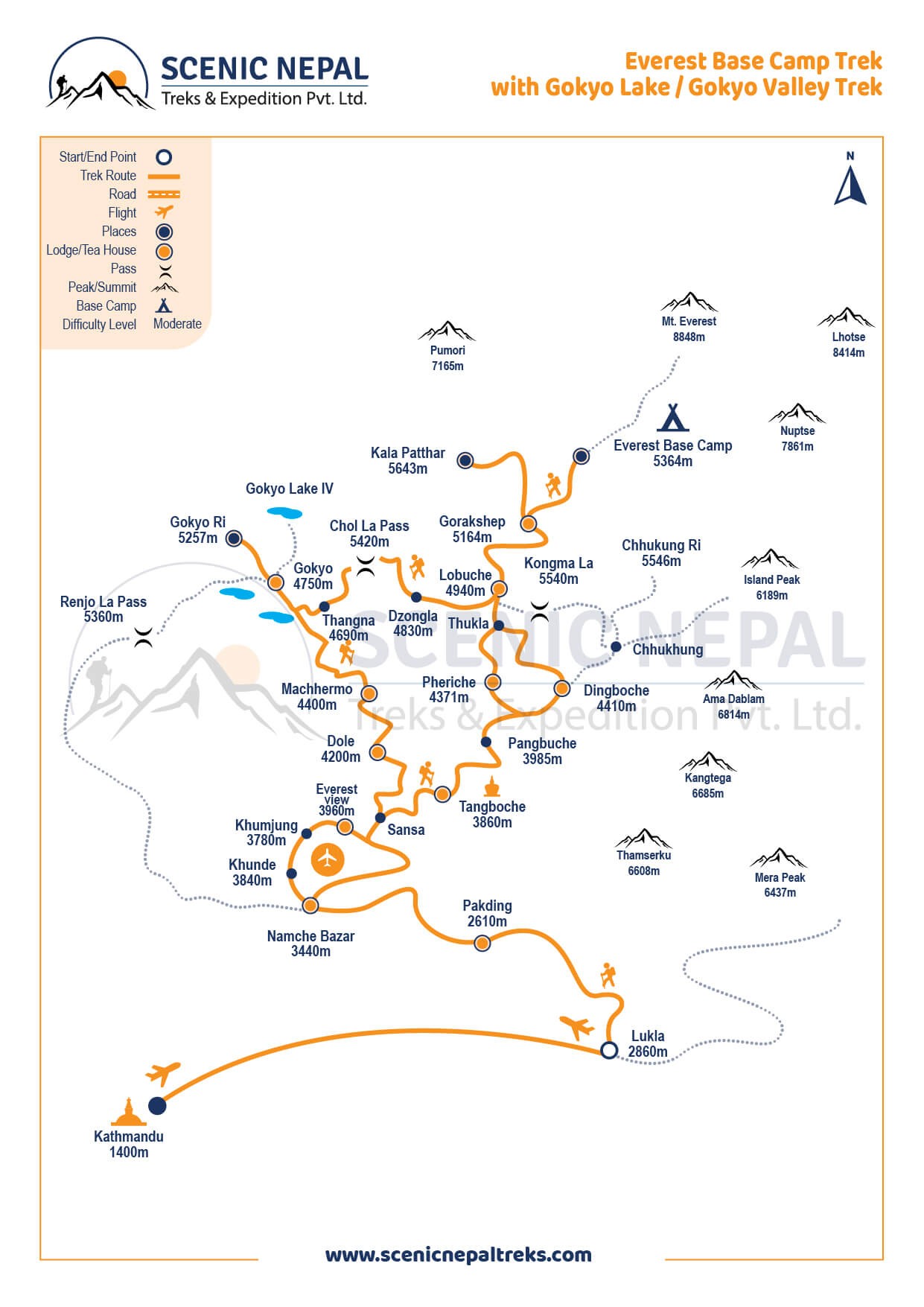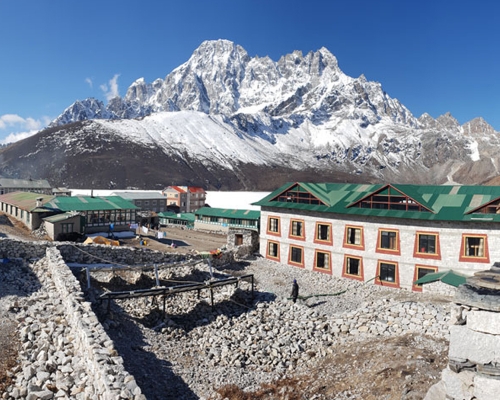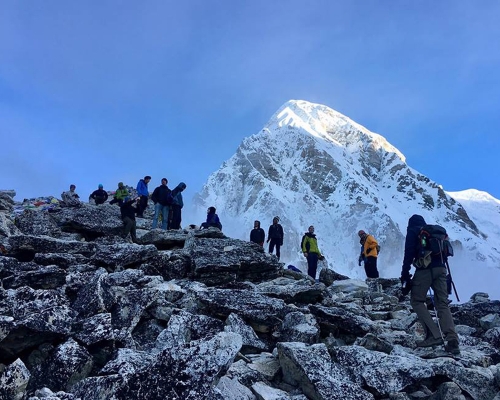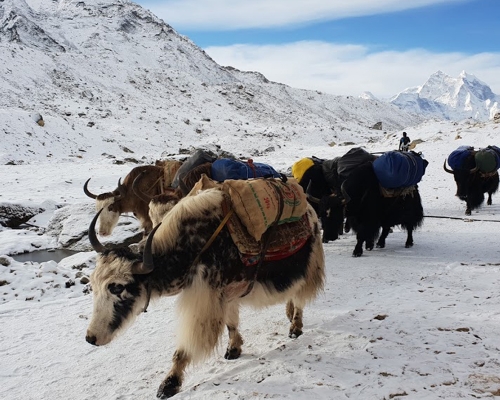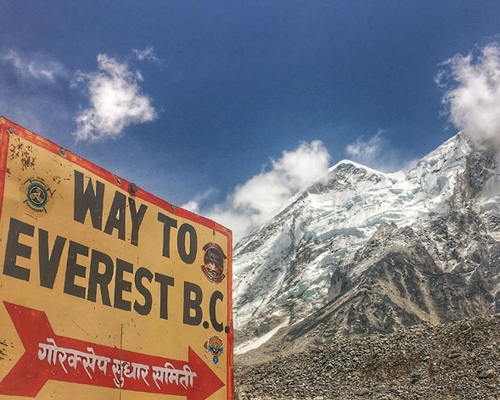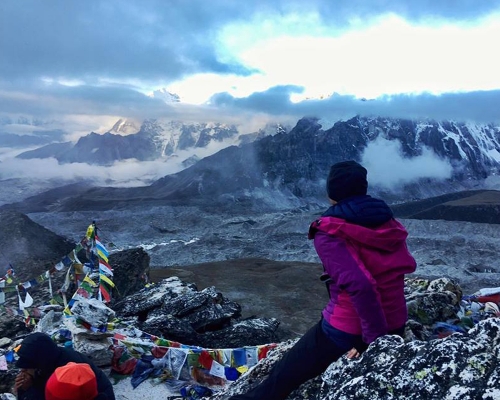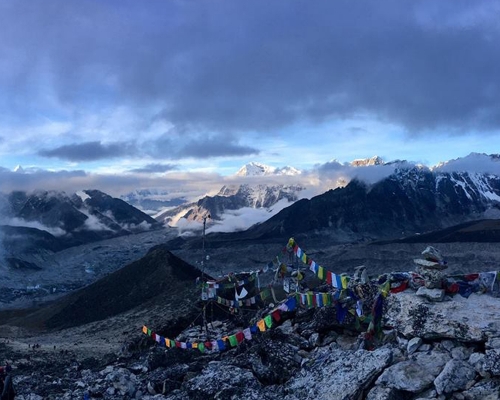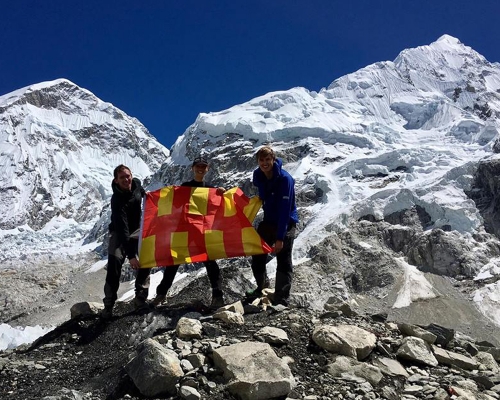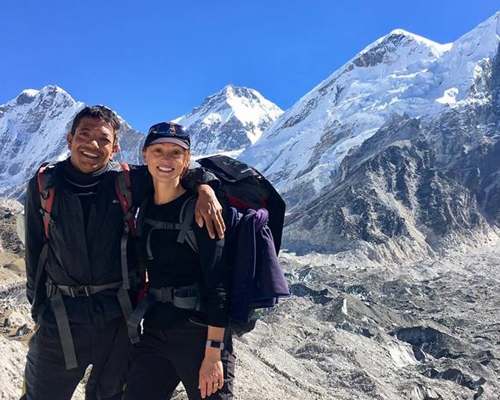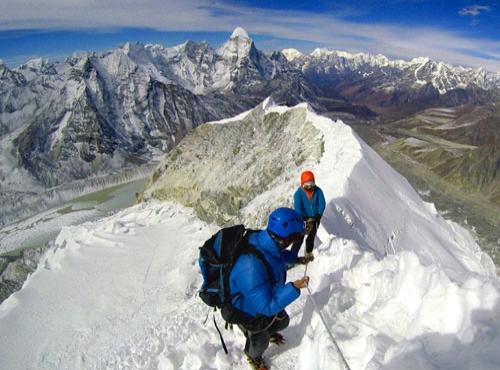Everest Base Camp and Gokyo Lakes Trek difficulty
The Everest Base Camp and Gokyo Lakes Trek is a quite challenging trek in the Everest region. The isolation of the region, long-distance, high elevation, steep ascents and descents, and rocky paths make Gokyo Lake trek more difficult than the Everest Base Camp Trek.
EBC Trek itself is a demanding trek, and the Gokyo Lake trek route adds furthermore adventure and challenge to the venture. The trail is off-the-beaten and involves 9 to 10 km of walk every day. It means 6 to 7 hours of walking daily. Therefore, the physical fitness of the trekker does matter a lot. Also, the walking hours may vary from one individual to another as per their walking speed.
Trekking in the Himalayas is different from trekking anywhere else. Even for experienced trekkers, it can get difficult. Along with good physical fitness, stamina and endurance are equally important. You will be exploring the part of the world that barely has any modern infrastructure. The accommodation and food option gets very basic with the increase in elevation. No internet or communication service most of the time.
So you see, resilience and determination are key to keeping yourself going. And the serene Himalayan landscape keeps fuelling you to move further. We recommend you to have 2 to 3 months of trek preparation time.
Build up your stamina, increase core body strength, and get used to long walking hours with a backpack. Cycling, swimming, running, and hiking are good ways to prepare for the trek. Likewise, you can also go to the gym and work on cardiovascular exercise.
Acclimatization and Altitude Sickness
To enjoy the trek to its fullest, you have to rest and acclimatize along the way. We will take breaks at places from where the views are stunning. To maintain the balance between walking long hours daily and also offering time to admire and soak the beauty of nature along the route, we have added ample acclimatization days in our Everest Base Camp and Gokyo Lakes Trek itinerary.
Acclimatization is essential to avoid altitude sickness. Altitude sickness is also known as acute mountain sickness (AMS) that trekkers usually face during the high-altitude journey. It is not something you should take lightly. Immediate attention is necessary to subside the symptoms to further improve.
Symptoms of altitude sickness
- Difficulty in breathing
- Nausea and vomiting
- Dizziness
- Loss of appetite and insomnia
- Headache
Your safety is our priority during the trek. Our trek guides are trained to keep you safe on the trail. They hold first-aid, remote survival, rock climbing, and many other certifications, which make them very reliable trekking partners.
At the same time, our guides are natives and experienced trekkers who have mapped almost all trekking trails in the Himalayas and lead many groups successfully. So, we can guarantee you a safe and sound venture in the Himalayas with us.
Preventive measures of altitude sickness
- If the symptoms get serious, then descend to the lower altitude immediately. Our guide will keep checking on you and decide whether you can continue trekking further or not. You are obliged to accept his decision as he is responsible for your and the group's safety.
- Acclimatization is important, therefore do check the itinerary and make sure there are enough rest days.
- Keep yourself hydrated. Drink at least 2 liters of water and other fluids like soup, tea, etc. Do not drink alcoholic drinks or smoke.
- Eat a balanced diet. Dal Bhat is the most nutritious and filling option you will find on the menu, so do include it in at least one meal.
Gokyo Lake Trek Solo/Private/Group
We never recommend trekking alone in the Himalayas to anyone. It's not safe. However, we offer a private trek option to travelers who want to do the Gokyo Lake trek solo. You will get accompanied by a guide and a porter to keep your company and make the trek comfortable.
Likewise, you can trek in a group with your friends and family or join one of our departure dates that will allow you to trek with travelers from different parts of the world. The perk of trekking in-group is sharing happy moments, making new friends, and of course, the low package cost.
Feel free to contact us anytime if you want to have a private trek or group trek with us.
Best time to go on Gokyo Lake Trek
Weather will either make or break your trekking experience in the Himalayas. Therefore, choosing the right time to trek is crucial too. The best time of the year to go on Everest Base Camp and Gokyo Lakes Trek is from March to April in spring and October to November in autumn.
Spring and autumn have the most stable weather, moderate climate, and clear views. The sky remains crystal clear from dusk till dawn, and the views are heavenly. Some trekkers also trek in winter and summer/monsoon, the off-seasons.
Spring and Autumn
These two seasons are perfect to trek in the Himalayas. Breath-taking views, warm daytime, colorful flowers, and a moderate climate makes the journey delightful. The temperature ranges from 18°C to -12°C in spring and 20°C to -5°C in autumn. Travelers from all around the world hit the trail. The nights and mornings are considerably chilly so prepare nicely.
Winter
January to February is the coldest time of the year in the Himalayas. Heavy snowfall covers the entire region, and it's very cold up there. Most of the lodges at higher elevations get closed, and locals drop down to lower altitudes to spend the winter. Likewise, the trail also gets blocked, and there are always high chances of avalanches. The daytime is warm, and the views are pretty clear and stunning. The temperature ranges from 15°C to -15°C and below.
Gokyo Lake Trek permit
To go on Everest Base Camp and Gokyo Lakes Trek, you have to get two permits. One is Khumbu Pasang Lhamu Rural Municipality Entrance Permit, and the second is Sagarmatha National Park Entry Permit.
You can get Sagarmatha National Park Permit in Kathmandu at Nepal Tourism Board Office or in Monjo.
Sagarmatha National Park Permit costs: NRS 3000 per person (approx. US$ 27)
The Khumbu Pasang Lhamu Rural Municipality Entrance Permit is available in Lukla or Monjo.
Khumbu Pasang Lhamu Rural Municipality Entrance Permit cost: NRS 2000 per person (approx. US$ 18)
*Note: If you are trekking with us, then we will arrange all the permits for you in advance, and the permit costs are covered in the package cost.
Accommodation
During the Everest Base Camp and Gokyo Lakes Trek, you will stay overnight in lodges. We will book the best possible lodges for you along the route. The rooms will come with an attached washroom. You can choose between a twin-sharing room and a single room. The villages at the lower elevation have luxury lodges too.
The rooms will be basic with a few pieces of furniture. We highly recommend you to carry a warm sleeping bag with you to spend cold nights. The dining area is like a common room, where you can enjoy the fireplace and spend some time with your friends.
In Kathmandu, you will stay overnight in a three-star hotel as per the itinerary. If you are arriving early or departing late than the confirmed itinerary, then all the extra expenses have to be covered by yourself.
Food during the trek
Look, you will be traveling in a remote area where there is no proper access to roadways, which makes everything scarce and expensive. Lukla, Phakding, Namche Bazar, and Tengboche have many food options compared to villages at a further higher elevation.
Our Everest Base Camp and Gokyo Lakes Trek package include three meals during the trek- Breakfast, lunch & dinner.
The breakfast menu usually consists of french toast with jam, butter, cheese, or honey. Likewise, you can also get hashed browns, eggs, pancakes, oatmeal, muesli, porridge, Tibetan bread, soup, hot chocolate, coffee, tea, and other bakery items.
Similarly, lunch and dinner look something like this- Dal Bhat, veggies, meat, Tibetan bread with various soups, stews, steaks, sandwiches, Momo, pasta, tenduk, noodles, thukpa, pizza, dessert, etc.
Trek Responsibly
One of our company's core values is to make sure that our ventures do not harm nature in any way. Over the years, we have learned and applied numerous measures to keep our treks and tours in nature eco-friendly. We are doing everything we can from our side, but we also believe that the equal participation of the travelers is significant too to protect the environment.
Below are the few things you can do from your side as a responsible traveler:
- Carry trash bags and collect your waste instead of throwing it randomly on the trail. Our team will help you decompose it properly at the appropriate place.
- Use sustainable products as much as you can.
- Carry a reusable water bottle.
- Give back to the local community by purchasing souvenirs.
- Respect locals and their culture.
Travel Insurance
Gokyo Lake trekking Nepal is a high-altitude trek that involves potential unseen climate changes and events that may need travel insurance. As the trip grade is challenging, travel insurance is necessary to book the trip.
To confirm the booking, the trekkers have to provide us with a copy of the travel insurance certificate. And the travel insurance must cover helicopter rescue (up to 6000 meters) and medical bills. We have all the right to deny the booking in case of the absence of proper travel insurance.
*Note: Do call and double-check with the insurance company whether their travel insurance covers helicopter rescue and evacuation up to 6000 meters or not.
Everest Base Camp via Gokyo Lake Trek Safety
Scenic Nepal Treks guarantee the safety and security of our dear guests. We have high satisfaction rates and a well-designed protocol that ensures the safety of the travelers and crew members on the trail. Before the beginning of the trek, our representative will guide you through the preparation and packing.
We will make sure you are well-prepared for the trek. All the gears and essentials are double-checked. Likewise, the team leader will brief you about the route and difficulties beforehand to mentally prepare you. In case of any emergency during the trek, our guide will assist you.
Last Minute Booking for Gokyo Lakes Trek
Try booking the trip at least a couple of months ago and have some preparation time on hand for Gokyo Lake Trekking. In case you need to book the Everest Gokyo Lake Trek at the last minute, then we offer a special provision for that.
You have to pay 100% of the package cost within 24 hours of confirmation of the trip from us. We will do our best to arrange everything at the last minute, but there can be delays due to weather, availability of lodging, etc. And, the company is not responsible for a situation that is beyond our control.
Travel Tips (electricity, internet, ATM, luggage, tipping, personal expenses)
- You may not get electricity all the time to charge your devices, therefore do carry extra batteries or a solar charger with you. Most of the places have charging stations where you can charge your device, but they may charge a few extra bucks.
- WiFi or cellular data may not be stable all the time. You can get WiFi services in villages like Lukla, Namche Bazar, Tengboche, etc, but the connection is not reliable all the time.
- There is no ATM above Namche Bazar, so withdraw enough cash to use it during the trek.
- A porter will be carrying your duffel bag during the trek. Each trekker has a weight limit of 10 kgs.
- If you are pleased with the service provided by our crew members, you can tip them. If you are confused about how much to tip, then this guide will give you an idea. USD 100 to trek guide/porter, USD 5 to tour guide, and USD 2 to the driver by each member of the group.
- All other expenses out of the itinerary are not covered in the package cost. It includes snacks, drinks, shopping, tipping, etc.
General Trekking Checklist:
This given Equipment is a general guide to the things that you may bring during trekking. Your trekking equipment list will be depending on the trekking Region and season that you are going to do. However, these are the most useful list that most of the trek and season you need to bring. We Scenic Nepal Treks recommend you to this bring Equipment as given:
Important documents and items
- Valid passport, 2 extra passport size photos, airline tickets
- Separate photocopies of passport, visa form (easily obtained at Kathmandu airport), proof of insurance
- Dollars, pounds, or Euros in cash for purchasing Nepalese visa at Kathmandu airport, for paying for restaurants and hotels, for gratuities, snacks, and to purchase your own drinks and gifts
- Credit cards, Bank/ATM/Cash machine cards for withdrawing funds from cash machines (bring a photocopy of your cards), traveler's checks, etc.
Head
- Bandana or headscarf, also useful for dusty conditions
- Warm hat that covers your ears (wool or synthetic)
- Headlamp with extra batteries and bulbs
- Sunglasses with UV protection
- Prescription sunglasses (if required)
Upper Body
- Polypropylene shirts (1 half sleeve and 2 long sleeves)
- Light and expedition weight thermal tops
- Fleece wind-stopper jacket or pullover
- Waterproof (preferably breathable fabric) shell jacket
- Down vest and/or jacket *
- Gore-Tex jacket with hood, waterproof and breathable
Hands
- 1 pair of lightweight poly liner gloves.
- 1 pair of lightweight wool or fleece gloves
- 1 pair of mittens, consists of 1 Gore-Tex over mitt matched with a very warm polar-fleece mitt liner (seasonal)
Lower Body
- Non-cotton underwear briefs
- 1 pair of Hiking shorts
- 1 pair of Hiking trousers
- 1 pair of lightweight thermal bottoms (seasonal)
- 1 pair of fleece or woolen trousers
- 1 pair of waterproof shell pants, breathable fabric
Feet
- 2 pairs of thin, lightweight inner socks
- 2 pairs of heavy poly or wool socks
- 1 pair of Hiking boots with spare laces (sturdy soles, water-resistant, ankle support, “broken-in”)
- 1 pair of trainers or running shoes and/or sandals
- Cotton socks (optional)
- Gaiters (winter only), optional, “low” ankle high version
Sleeping
- 1 sleeping bag (Scenic Nepal Treks will provide you)
- Fleece sleeping bag liner (optional)
Rucksack and Travel Bags
- 1 medium rucksack (50-70 liters/3000-4500 cubic inches, can be used for an airplane carryon)
- 1 large duffel bag ( Scenic Nepal Treks will Provide you if you are having Porter)
Medical
- Small, personal first-aid kit. (simple and light)
- Aspirin, first-aid tape, and plasters (Band-Aids)
- 1 skin-blister repair kit
- Anti-diarrhea pills
- Anti-headache pills
- Cough and/or cold medicine
- Anti-altitude sickness pills: Diamox or Acetazolamide
- Stomach antibiotic: Ciprofloxacin, etc. Do not bring sleeping pills as they are respiratory depressants.
- Water purification tablets or the water filter
- 1 set of earplugs
- Extra pair of prescription glasses, contact lens supplies
Toiletries
- 1 medium-sized quick-drying towel
- Toothbrush/paste (preferably biodegradable)
- Multipurpose soap (preferably biodegradable)
- Deodorants
- Nail clippers
- Face and body moisturizer
- Female hygiene products
- Small mirror
- Personal Hygiene
- Wet wipes (baby wipes)
- Tissue /toilet roll
- Anti-bacterial handwash
Preparation Tips
- Test Your Gear: Before the trek, make sure all your gear is in good condition and comfortable.
- Pack Light: Aim to pack only essential items to keep your load manageable.
- Stay Informed: Keep up-to-date with weather conditions and trek advice.
Book Your Trek Today
Ensure you have everything on this checklist for a successful Everest Base Camp and Gokyo Lake trek. For more information and to book your adventure, visit our website or contact us here
.jpg)
